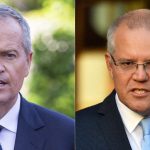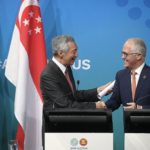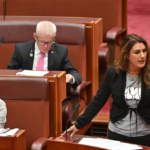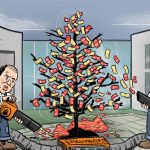Early election ultimatum
It seems unlikely that the Australian Building and Construction Commission bill will pass the Senate, and Australia might well be faced with a double dissolution election on 2 July. Political scientist Dominic O’Sullivan says both the ALP and the Coalition now need to develop a coherent strategy.
The Prime Minister’s strategy is to make this year’s election a contest between law and order and union thuggery; to contrast himself on the side of righteousness, with the Opposition Leader on the side of lawlessness.
The strategy’s first part is to have the Senate once again reject the legislation to re-establish the Australian Building and Construction Commission. This would constitutionally justify a double dissolution election on 2 July. The election would occur under new rules that the Prime Minister will promote as giving voters – not the faceless men, not the preference whisperers – decisive influence over who will sit in the next Senate.
However, politics is never this simple. The Government has already rejected proposals to extend the powers of the proposed construction industry ‘watchdog’ to the whole economy; not just the Construction, Forestry, Mining and Energy Union (CFMEU) as if it were Australia’s sole repository of lawlessness. If these extended powers are unnecessary, the Government needs to make its case; it needs to refute Bill Shorten’s argument that if there is lawlessness in the CFMEU, it is properly a matter for the police. Indeed, police investigations and prosecutions may well suggest that existing responses are sufficient and that the Government’s motivation is an ideologically inspired, anti-union ‘witch hunt’. However, for the ALP there is the risk that the argument fails and that its political vulnerability on this issue diverts campaign attention from those on which the party might more successfully campaign.
The ALP is too close to the CFMEU and too dependent on union financial support to change easily its position, even though the only sure way of removing it from the campaign’s focus is to let the legislation pass. The best outcome then from a Labor perspective would be for the Senate cross-bench, most of which would struggle to retain their positions at a double dissolution, to succumb to self-interest, allow the legislation to pass and allow themselves to serve their full terms. Although there are yet no signs that this will happen, the tension between principle and pragmatism will test individual resolve.
The Government’s intention conceals its vulnerability on other issues, and an immediate pragmatic priority for the ALP must be to gain control of the campaign agenda; to ensure attention to those aspects of industrial relations on which it might find relative strength. There is a natural Labor constituency concerned with protecting penalty rates and constraining a Workchoices style industrial relations regime that retains support within the Coalition.
Shorten says he wants to campaign on a ‘fair tax’ policy, the protection of Medicare, family support and more spending on health and education. To do this, he desperately needs the CFMEU removed from public consciousness. He also needs a clear economic plan and description of what is to be achieved from additional spending.
The commitment to the Gonski plans for the funding of schools provides an important contrast with the Coalition and a point on which the ALP is clearly on the right side of public opinion. Funding Gonski through a ‘fair tax’ policy may also create a contest on which the Coalition is vulnerable; especially if the centrepiece of its Budget on 3 May is significant company tax cuts, but no corresponding measures for wage and salary earners. The ‘fairness’ test that the Coalition’s first budget failed so miserably cannot be repeated just weeks out from a double dissolution election. If the perception of concern only for ‘big business’ develops, the argument that the Building and Construction legislation is ideologically inspired ‘union bashing’ may gain momentum.
The Coalition, too, requires a clearer economic plan, especially following the indecisiveness that has so far distinguished its tax policy position. Indecisiveness firstly created the fear of a highly regressive increase to the GST, followed by false expectations of significant personal income tax cuts. The former was abandoned when the government’s own modelling showed it would not have a positive impact on economic growth. So there is scope for its opponents to present the Coalition not as the competent economic manager it claims, but as a government bereft of coherent and principled ideas. Tax cuts for the rich and witch hunts won’t do. However, to create that image Labor needs to do more than spend and hope.
As well as the national picture and whether or not a double dissolution occurs, there are interesting and important local contests at play. Polls in the Deputy Prime Minister Barnaby Joyce’s seat of New England show the seat’s former independent member, Tony Windsor, in front. The former Liberal member for Indi, Sophie Mirabella, is running a very strong campaign to regain her seat from the Independent, Cathy McGowan. However, McGowan is popular across the electorate and the Nationals are seriously contesting the seat and rarely does a candidate attract such deeply held dislike as Mirabella. The New South Wales state member of Parliament, Linda Burney, is likely to contest the seat of Barton for Labor and become the first indigenous woman elected to the House of Representatives. The former Democratic Labor Party, now independent senator, John Madigan is unlikely to be re-elected, while at a double dissolution Nick Xenophon is expected to be returned with additional party representation. The former Palmer United Party, now independent senators, Jackie Lambie and Glenn Lazarus will mount assertive campaigns, and the outcome in all these cases are potentially important to the formation of government.

Dominic O’Sullivan is Professor of Political Science at Charles Sturt University and Adjunct Professor in the Centre for Maori Health Research at the University of Auckland University of Technology. His recent publications include ‘We Are All Here to Stay’: citizenship, sovereignty and the UN Declaration on the Rights of Indigenous Peoples and Sharing the Sovereign: Recognition, Treaties and the State.















